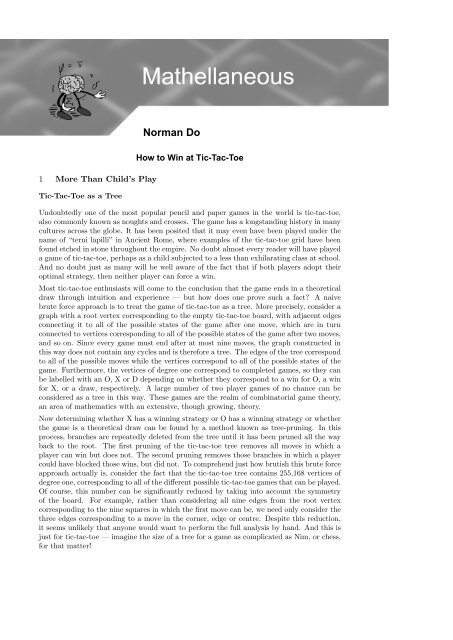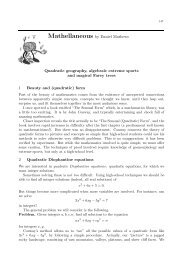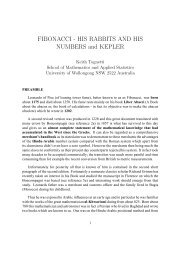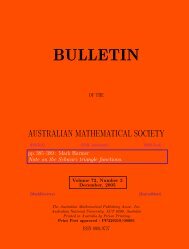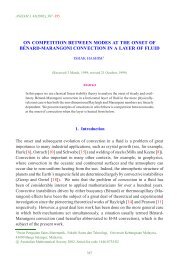Gazette 31 Vol 3 - Australian Mathematical Society
Gazette 31 Vol 3 - Australian Mathematical Society
Gazette 31 Vol 3 - Australian Mathematical Society
You also want an ePaper? Increase the reach of your titles
YUMPU automatically turns print PDFs into web optimized ePapers that Google loves.
1 More Than Child’s Play<br />
Tic-Tac-Toe as a Tree<br />
Norman Do<br />
How to Win at Tic-Tac-Toe<br />
Undoubtedly one of the most popular pencil and paper games in the world is tic-tac-toe,<br />
also commonly known as noughts and crosses. The game has a longstanding history in many<br />
cultures across the globe. It has been posited that it may even have been played under the<br />
name of “terni lapilli” in Ancient Rome, where examples of the tic-tac-toe grid have been<br />
found etched in stone throughout the empire. No doubt almost every reader will have played<br />
a game of tic-tac-toe, perhaps as a child subjected to a less than exhilarating class at school.<br />
And no doubt just as many will be well aware of the fact that if both players adopt their<br />
optimal strategy, then neither player can force a win.<br />
Most tic-tac-toe enthusiasts will come to the conclusion that the game ends in a theoretical<br />
draw through intuition and experience — but how does one prove such a fact? A naive<br />
brute force approach is to treat the game of tic-tac-toe as a tree. More precisely, consider a<br />
graph with a root vertex corresponding to the empty tic-tac-toe board, with adjacent edges<br />
connecting it to all of the possible states of the game after one move, which are in turn<br />
connected to vertices corresponding to all of the possible states of the game after two moves,<br />
and so on. Since every game must end after at most nine moves, the graph constructed in<br />
this way does not contain any cycles and is therefore a tree. The edges of the tree correspond<br />
to all of the possible moves while the vertices correspond to all of the possible states of the<br />
game. Furthermore, the vertices of degree one correspond to completed games, so they can<br />
be labelled with an O, X or D depending on whether they correspond to a win for O, a win<br />
for X, or a draw, respectively. A large number of two player games of no chance can be<br />
considered as a tree in this way. These games are the realm of combinatorial game theory,<br />
an area of mathematics with an extensive, though growing, theory.<br />
Now determining whether X has a winning strategy or O has a winning strategy or whether<br />
the game is a theoretical draw can be found by a method known as tree-pruning. In this<br />
process, branches are repeatedly deleted from the tree until it has been pruned all the way<br />
back to the root. The first pruning of the tic-tac-toe tree removes all moves in which a<br />
player can win but does not. The second pruning removes those branches in which a player<br />
could have blocked those wins, but did not. To comprehend just how brutish this brute force<br />
approach actually is, consider the fact that the tic-tac-toe tree contains 255,168 vertices of<br />
degree one, corresponding to all of the different possible tic-tac-toe games that can be played.<br />
Of course, this number can be significantly reduced by taking into account the symmetry<br />
of the board. For example, rather than considering all nine edges from the root vertex<br />
corresponding to the nine squares in which the first move can be, we need only consider the<br />
three edges corresponding to a move in the corner, edge or centre. Despite this reduction,<br />
it seems unlikely that anyone would want to perform the full analysis by hand. And this is<br />
just for tic-tac-toe — imagine the size of a tree for a game as complicated as Nim, or chess,<br />
for that matter!


